Key takeaways:
- Diffusion techniques in art create emotional resonance, movement, and invite deeper viewer connections, transforming art into a shared experience.
- Choosing a diffusion technique involves considering the emotion to convey, the materials used, and the intended message to enhance the artwork’s narrative.
- Common mistakes to avoid include neglecting brush cleanliness, rushing the drying process, and not accounting for canvas texture, which can significantly affect the final outcome.
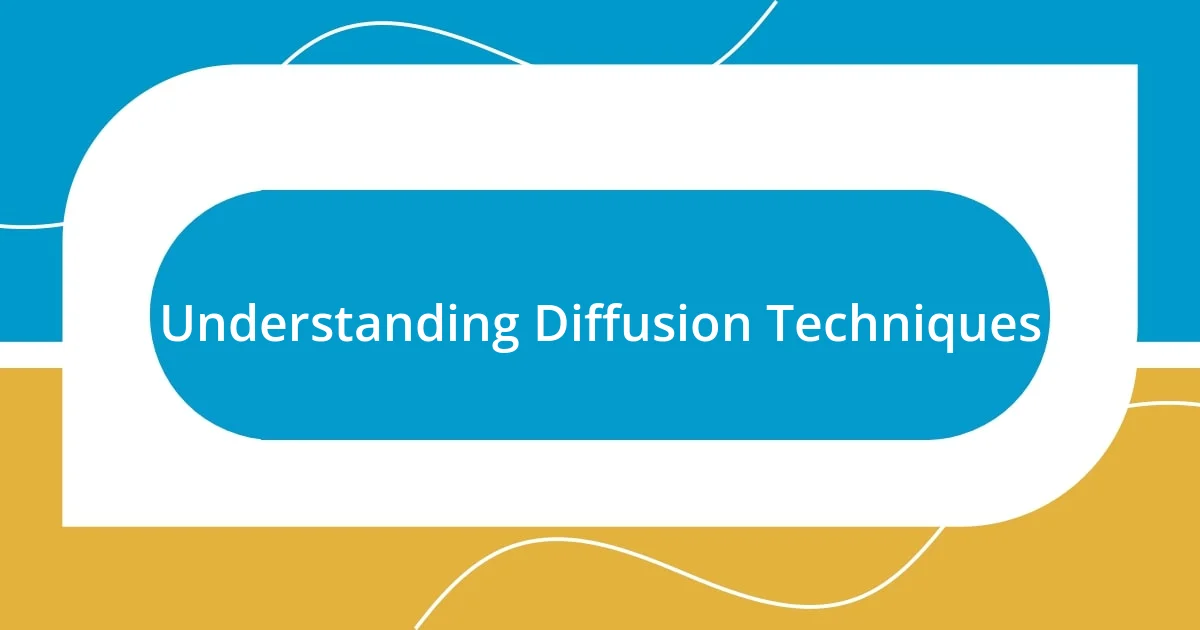
Understanding Diffusion Techniques
Understanding diffusion techniques in art and design can feel like embarking on a fascinating journey. Each technique, whether it’s softening edges or allowing elements to blend seamlessly, serves to evoke feelings and moods. Have you ever found yourself mesmerized by a particularly ethereal painting? That’s often the result of skilled diffusion, where the artist masterfully blurs the lines between distinct forms.
One of my favorite moments was when I first experimented with diffusion in my own work. I vividly remember applying a wet-on-wet watercolor technique, letting colors flow into each other like gentle whispers. The unpredictability of how the colors melded filled me with both excitement and a touch of anxiety—what if it didn’t turn out as I envisioned? Yet, experiencing that spontaneous creativity taught me that diffusion isn’t just a method; it’s a dance between control and freedom.
As I reflect on my journey, I can’t help but wonder: how does diffusion resonate with your creative process? I’ve learned that understanding these techniques goes beyond just technical knowledge; it’s about embracing the emotional connections they can foster. It allows us to narrate stories through our art, inviting viewers to feel rather than just see.
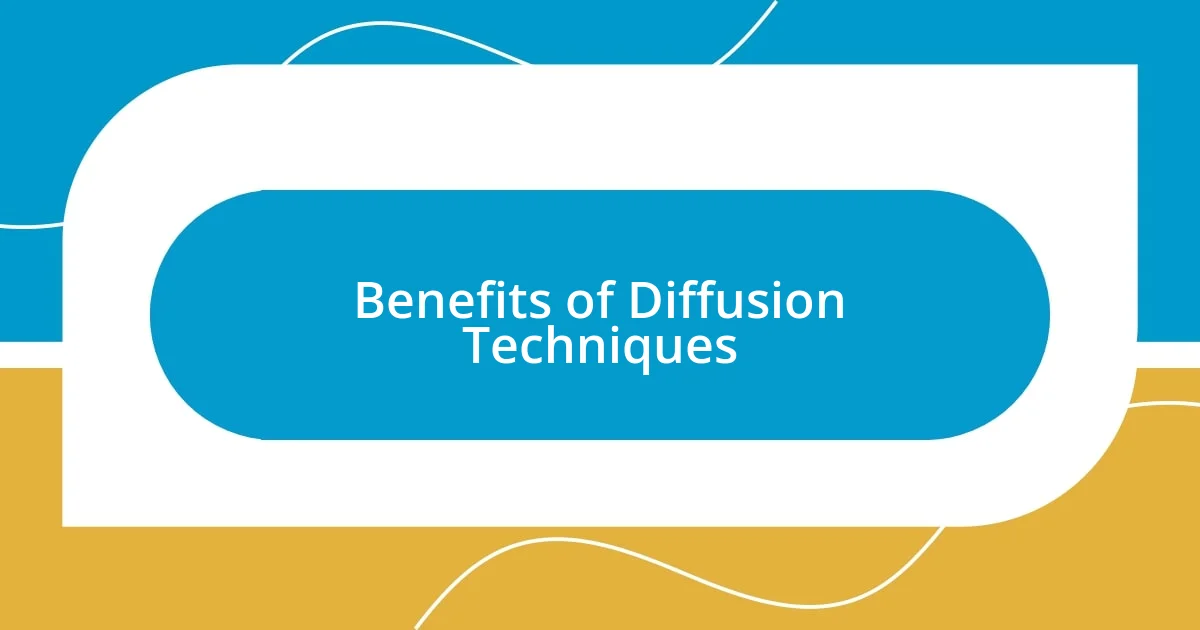
Benefits of Diffusion Techniques
The benefits of diffusion techniques in art and design are profound. For me, using these techniques has often resulted in an unexpected depth of emotion in my work. I recall a time when I layered different colors in a landscape painting. The way the hues blurred together not only created a sense of movement but also stirred feelings of nostalgia. It transported me back to a serene moment in nature, evoking the same warmth and tranquility I felt then.
- Enhances emotional resonance of artwork
- Fosters a sense of movement and fluidity
- Encourages creativity through unexpected outcomes
- Allows for blending of colors, creating a cohesive composition
- Invites viewers to connect on a deeper level
By embracing diffusion, I’ve found that my creations not only capture visual interest but also tell a story. Each technique offers a new layer of interaction between the piece and the viewer, making art a shared experience rather than a solitary one.

Types of Diffusion Techniques
When discussing diffusion techniques, it’s essential to appreciate the variety that exists. For instance, I’ve often turned to softening techniques, where I gently blur hard edges to create a dreamlike quality in my artwork. This approach resonates deeply with me—it feels like I’m inviting the viewer into an intimate moment, allowing them to explore their own emotions within a soft, inviting space.
Another technique I cherish is layering, which adds texture and depth to my creations. I remember a specific illustration where I stacked translucent colors over each other, resulting in a vibrant glow that seemed to pulse with life. This process is a bit like storytelling; each layer adds a new chapter, and the viewer is encouraged to dive deeper to uncover what lies beneath.
Lastly, there’s the method of blending colors seamlessly. I particularly enjoy this approach in my abstract pieces. The fluidity created by unifying hues allows me to transport emotions, almost like creating an atmosphere rather than a specific image. It’s a spontaneous act—much like the ebb and flow of a tide—and it reflects the unpredictable nature of artistic expression.
| Type of Technique | Description |
|---|---|
| Softening | Blurring edges to create a gentle, dreamy effect that invites emotional connection. |
| Layering | Building depth and texture through transparent colors, much like layering a story over time. |
| Blending | Seamlessly merging colors to evoke an atmosphere, reflecting spontaneity in creative expression. |

How to Choose a Technique
Choosing the right diffusion technique can be a delightful challenge. When I’m faced with a selection, I often reflect on the emotion I want to convey. For example, if I’m aiming for a sense of tranquility, I might lean toward softening techniques. Have you ever thought about how the type of technique can shift the mood of your artwork entirely?
Another aspect that guides my choice is the specific materials I’m using. The texture of my canvas or paper can make a significant difference. I’ve had moments where I picked a layering approach only to find the colors interacting in unexpected ways due to the surface’s absorbency. It’s almost like letting the materials speak for themselves; doesn’t that spark your curiosity about experimentation?
Lastly, I pay close attention to the message I wish to communicate. When I once created a piece expressing chaos, blending was my go-to. The unification of colors mirrored the chaotic emotions I wanted to portray, creating an almost tangible tension. Have you considered how your choice of technique can enhance the narrative of your work? Recognizing this connection helps in better executing your vision.
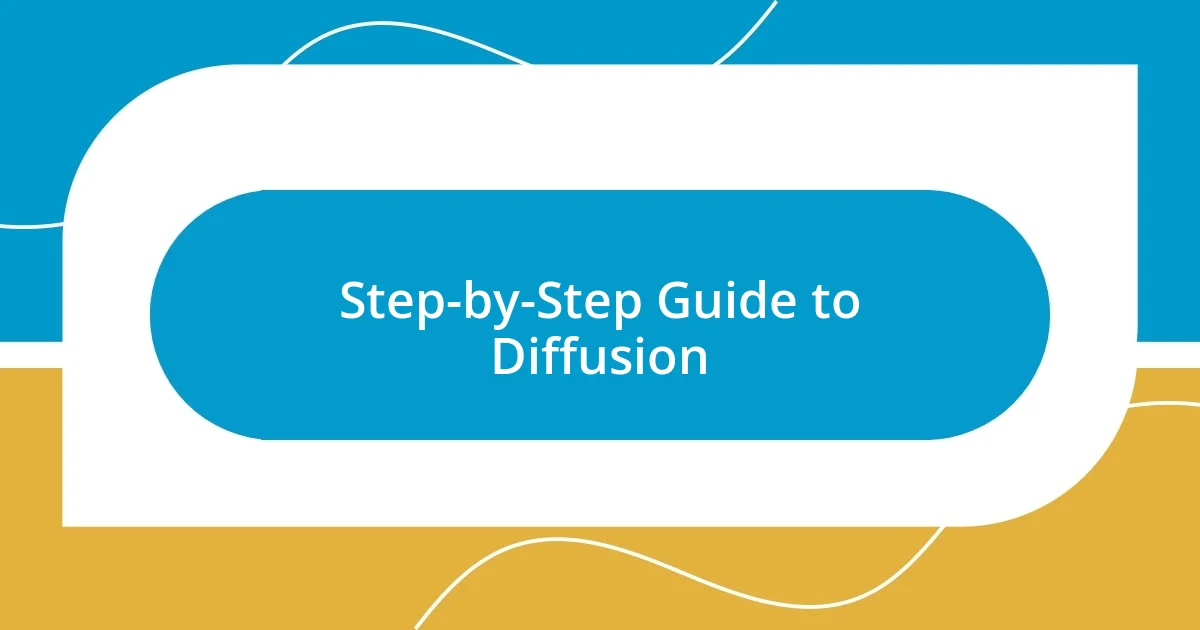
Step-by-Step Guide to Diffusion
When embarking on diffusion, I always start by prepping my materials. I gather my brushes, paints, and textures because each has its own personality that adds to the effect. I recall one evening, lost in the hues of sunset, I decided to experiment by mixing colors directly on the canvas. This spontaneous choice was my first step, igniting a vibrant conversation between the colors on my palette and those on my brush.
Next, I approach the actual application. I determine whether to soften, layer, or blend based on what feels right in that moment. I remember a day when I wanted to create an ethereal landscape; I instinctively reached for my softening technique. The way the colors melted into each other evoked a place where reality meets dream and took me on an unexpected emotional journey. Have you ever felt that bliss when every stroke resonates with your inner vision?
Finally, I step back and evaluate my work. This part is crucial; it’s how I gauge whether the diffusion truly captures the essence I’m aiming for. I often find myself reflecting, asking if the colors communicate the feeling I intended. Once, after layering multiple translucent colors, I took a breath and realized that the piece vibrated with energy. It was in that moment of recognition that I understood how essential this step is for bringing my artistic vision to life.
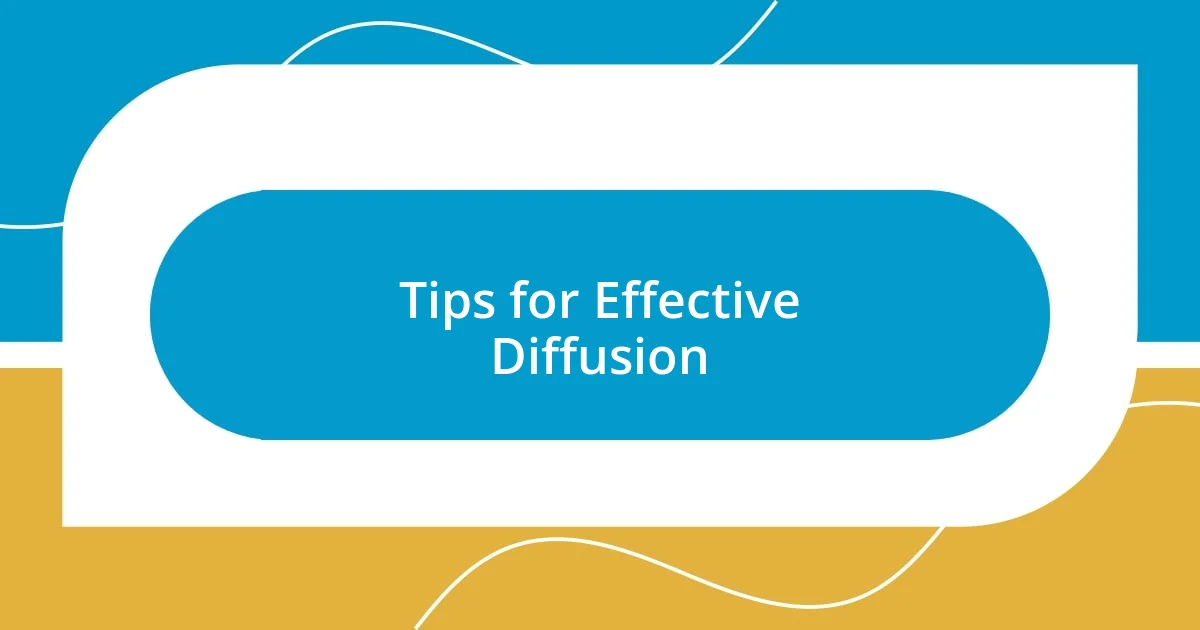
Tips for Effective Diffusion
For effective diffusion, it’s essential to understand your environment. I remember a time I was working in a vibrant outdoor setting, and I quickly realized how the changing light affected my colors. Each stroke seemed alive, shifting with the sunlight. Have you considered how the time of day or lighting conditions might transform the way your colors diffuse?
Another crucial tip is to be patient with the process. I once rushed a piece, eager to see the final outcome, and ended up with muddied colors rather than a harmonious blend. Taking the time to let layers dry before adding more can lead to surprising depth and richness. Isn’t it interesting how sometimes the most beautiful outcomes emerge from moments of waiting?
Finally, don’t hesitate to break the rules. Last year, I experimented by using sponge applicators instead of my usual brushes, and the results were electrifying. The unexpected textures added a new dimension to my work that I hadn’t anticipated. I often ask myself—what if I challenge my usual techniques? The answers can lead to stunning, unique pieces that reflect your artistic journey.
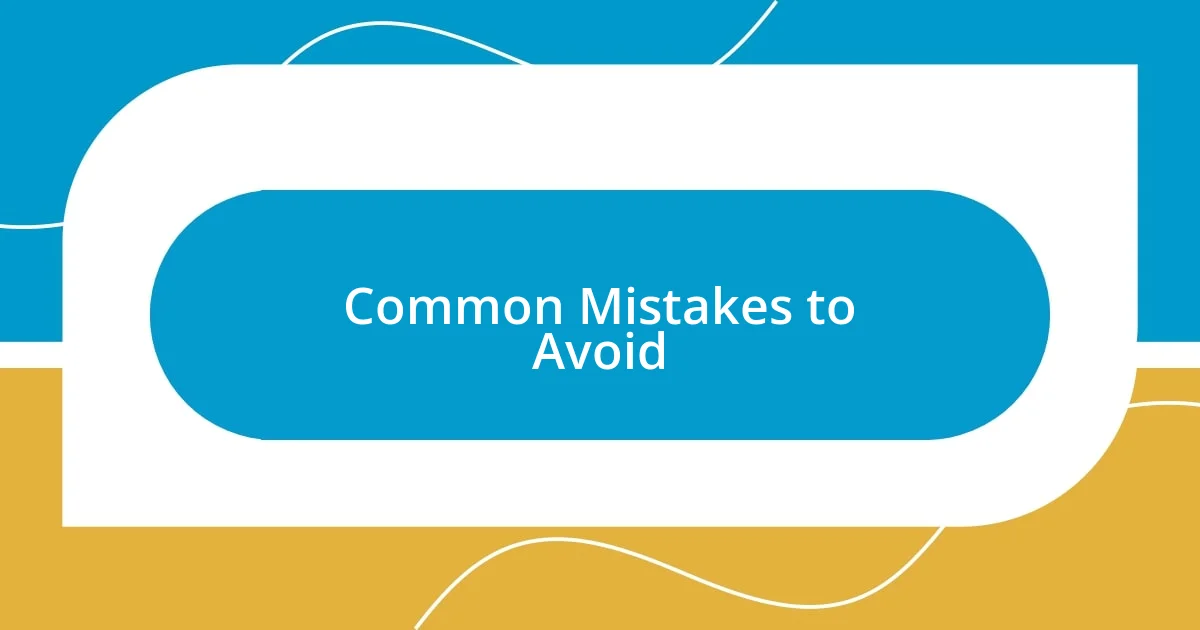
Common Mistakes to Avoid
When diving into diffusion techniques, one common mistake I see often is neglecting to clean your brushes thoroughly. I once finished a captivating session, only to find remnants of previous colors mingling in my new work. The unexpected results pulled my piece in a direction I hadn’t intended, leading to frustration rather than inspiration. Have you ever been surprised by what a dirty brush can do?
Another pitfall is rushing the drying process. I recall a time I was so excited about my fresh creation that I impatiently introduced new layers while prior ones were still wet. The result? A chaotic blend that strayed far from my original vision. It taught me the value of patience; letting each layer breathe can transform a muddled vision into a masterpiece.
Finally, failing to consider the canvas texture can hinder your diffusion journey. I remember challenging myself with a rough-textured canvas, thinking the grit would enhance my work. Instead, it absorbed paint in ways that clashed with my vision. I learned to respect the canvas’s characteristics as an instrumental player in the diffusion process. How does your canvas choice influence the overall outcome of your work?












